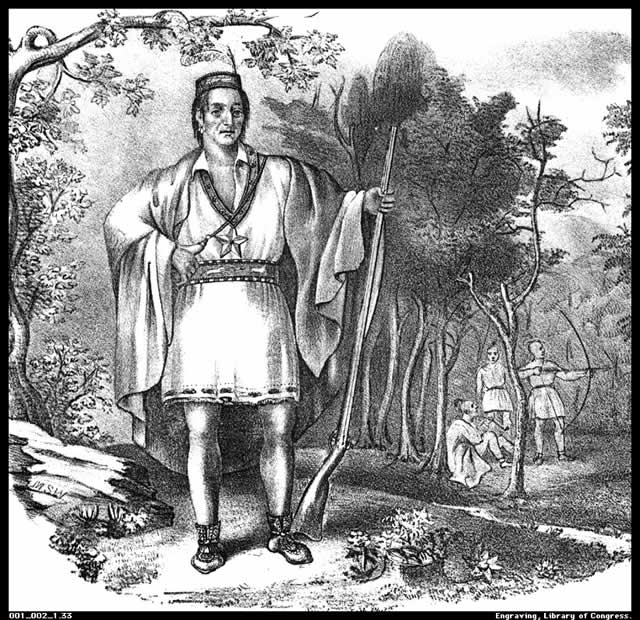|
Aug
14, 1806:
|
Lewis
and Clark first reach a MINNETAREE and MANDAN village.
|
|
|
Aug
15, 1514:
|
Spanish
Bishop Bartoleme de las Casas releases the Indians he holds
as serfs in Hispaniola.
|
|
|
Aug
16, 1851:
|
One
in a series of treaties with California Indians is signed
at Reading's Ranch. The treaty is designed to reserve lands
and to protect the Indians.
|
|
|
|
|
Metacom,
known as King Philip, was chief of the Wampanoag Indians
and son of Massasoit, who lived peacefully with the
settlers since the
arrival of the Pilgrims. King Philip, however, saw that
whites were expanding into Indian territory, and made
plans to resist. King Philip and a band of Wampanoags
vandalized a frontier community in the 17th century,
had begun. Although the Narragansett and Nipmuck Indians
joined forces with the Wampanoags, King Philip sensed
defeat and fled into the forest. The near annihilation
of the Narragansett Indians in 1676 ended hostilities,
leaving six hundred colonists and even more Indians,
including King Philip, dead.
|
|
|
Aug
17, 1755:
|
Almost
400 Indians attack John Kilburn’s stockade at Walpole,
Connecticut. Some sources say the Indians are led by King
Philip. After a day of fighting, the Indians withdraw.
|
|
|
Aug
18, 1804:
|
Lewis
and Clark meet with the OTTOs to discuss the war with the
Maha.
|
|
|
Aug
19, 1854:
|
A
Miniconjou SIOUX, named High Forehead, kills a sickly cow
near Fort Laramie, in southeastern Wyoming. The cow's owner
complains to the fort's commander. A brash Brevet Second Lieutenant
John L. Grattan, and thirty volunteers leave the fort to find
the SIOUX involved. Grattan goes to Conquering Bear's Brule
SIOUX camp near Ash Hollow, and demands the Indian who shot
the cow. Grattan makes numerous threats to the SIOUX, but
they won't hand over High Forehead. During the parlay, a shot
rings out, and Grattan's artillery gunners open fire on the
camp. Conquering Bear tries to get both sides to stop shooting,
but he is hit by an artillery round. Eventually, all but one
of Grattan's men are killed in the fighting.
|
|
|
|
|
At
the negotiations of the Fort Laramie treaty, Chief
Man Afraid of His Horses smokes the sacred pipe
with white goverment forces.
|
|
|
|
Aug
20, 1789:
|
An
"Act Providing for the Expences Which May Attend Negotiations
or Treaties with the Indian Tribes, and the Appointment of
Commissioners for Managing the Same" is approved by the
United States.
|
|
|
Aug
21, 1847:
|
The
Pillager Band of CHIPPEWA sign a treaty (9 stat. 908) at Leech
Lake.
|
|
|
Aug
22, 1806:
|
Pike’s
expedition has reached a village of the Little OSAGE near
the forks of the Osage River in modern Missouri. He holds
a council here with both the Grand and Little OSAGE. The Little
OSAGE are lead by Tuttassuggy or "The Wind," and
the Grand OSAGE by Cheveau Blanc, or White Hair.
|
|
|

Fort
Carlton was built by the Hudson's Bay Company in 1810. It
was situated on a valley floor at a natural fiord in the North
Saskatchewan River. The fort remained an important post for
75 years, as it was located near a major waterway, and the
west's most important overland route, the Carlton Trail, which
linked Lower Fort Garry (Winnipeg) and Fort Edmonton.
|
|
Aug
23, 1876:
|
"Treaty
6 Between Her Majesty The Queen and The Plain and Wood CREE
Indians and Other Tribes of Indians at Fort Carlton, Fort
Pitt and Battle River with Adhesions" is signed in Canada.
|
|
|
Aug
24, 1835:
|
The
United States signs a treaty (7 Stat., 474.) with the CHOCTAW,
COMANCHE, CREEK (Muscogee), CHEROKEE, OSAGE, QUAPAW, SENECA
and WITCHITA at Camp Holmes "on the eastern border of
the Grand Prairie, near the Canadian River." Governor
Montfort Stokes, Brigadier-General M. Arbuckle, represent
the U. S. Many Indians sign the treaty.
|
|
|
Aug
25, 1737:
|
An
agreement is signed by Thomas Penn and MUNSEE Chiefs Manawkyhickon
and Nutimus. Teeshacomin and Lappawinzoe also sign. The agreement
recognizes an old deed made in 1686. The agreement calls for
Indian lands to be sold along the Delaware River for the distance
that a man can walk in a day and a half. This is called the
"Walking Purchase" and is performed on September
19, 1737.
|
|
|
Aug
26, 1842:
|
The
CADDOEs sign a treaty in Texas. They agree to visit other
tribes and try to convince them to also sign treaties with
Texas.
|
|
|
Aug
27, 1878:
|
Captain
James Egan, and Troop K, Second Cavalry, are following a group
of BANNOCKs, who have been stealing livestock along the Madison
River. Near Henry's Lake, Captain Egan's forces skirmish with
the BANNOCKs, and recover fifty-six head of livestock. The
escaping BANNOCKs are starting to follow the trail taken by
the NEZ PERCE, last year.
|
|
|
|
|
|

|
|
|
|
|
    
|
|
    
|
|
|
|
| |

|
|
| |
Canku Ota is a free Newsletter celebrating Native
America, its traditions and accomplishments . We do not provide subscriber
or visitor names to anyone. Some articles presented in Canku Ota may
contain copyright material. We have received appropriate permissions
for republishing any articles. Material appearing here is distributed
without profit or monetary gain to those who have expressed an interest.
This is in accordance with Title 17 U.S.C. Section 107. |
|
|
|
|
| |
Canku Ota is a copyright © 2000,
2001, 2002, 2003, 2004 of Vicki Barry and Paul Barry.
|
|
 |
|
 |
|
The "Canku Ota -
A Newsletter Celebrating Native America" web site and its design
is the
|
|
Copyright ©
1999, 2000, 2001, 2002, 2003, 2004 of Paul C. Barry.
|
|
All Rights Reserved.
|
|



